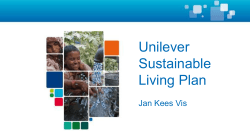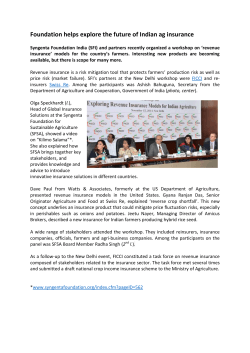
ESRF POLICY BRIEF - Economic and Social Research Foundation
NO. 2/2014 ESRF POLICY BRIEF ECONOMIC AND SOCIAL RESEARCH FOUNDATION www.esrf.or.tz Formal Agricultural Financing in the Rural Economy of Tanzania By Hossana Mpango ABSTRACT The Tanzania financial sector reforms that commenced in early 1990s have encouraged private players to enter the financial sector, increasing competition in banking, as well as the number and types of formal and informal financial institutions. However, these financial institutions rarely serve the agricultural sector which is the backbone of Tanzania’s economy and the livelihood of majority of the rural population. As a result, traps have been created which reproduce poverty over time and depress the rate of rural growth. Many African countries, Tanzania included have been implementing macroeconomic, sectoral and institutional reforms aimed at ensuring sustainable economic growth and poverty reduction. Having 70.4 per cent of the population residing in rural areas (URT, 2011) and being highly dependent on the agriculture sector which absorbs 75 percent of the entire workforce (TIC Investment guide 2013-2014); the Tanzania government acknowledged the necessity of pursuing different approaches to improve the agricultural sector. One such approach has been to increase agricultural credit so as to enable farmers to afford new production technologies such as improved seed varieties, fertilizers, farming implements and chemicals. The expected results being higher levels of investments in the sector, increasing agricultural output, raising agricultural income for the farmers, reducing food expenditure and eventually improving the farmers’ livelihood and reduce poverty. Over the years the Tanzania government in collaboration with its development partners have initiated schemes, programmes and institutions to increase access to financial services for farmers- most of which reside in rural areas. Examples are the First and Second Generation Financial Sector Reforms, Rural Development Strategy (2001) and the Agriculture Sector Development Program and Strategy I (2001). However, the interventions have not been able to fully achieve their objectives because of uncertainties associated with the sector– including poor farming systems and unpredictable factors as drought which discourage most of the banks and other financial institutions to extend substantial credit to finance agrarian projects. Over the years, the share of commercial banks’ loans to ESRF POLICY BRIEF Page 2 agriculture has remained low compared to manufacturing, trade, and other services sectors. The presented government statistics are supported by the 2013 FinScope Tanzania survey results which revealed that it is only 6.8% of the rural population that use bank products. This has negative implications to the overall performance of the agricultural sector. Access to financial services has an imperative role to play in upgrading production, processing, storage and marketing activities in order to improve smallholder farmers’ revenues and bring socio-economic development in the rural areas. Agricultural Finance in Tanzania: Challenges Agricultural production in Tanzania is dominated by small holder famers most of which reside in rural areas. These rural farmers are critical to the attainment of food security and as they produce the bulk of food items for consumption in the cities and for export. Despite the contributions of the small-holders and their potentials for overall national development, they struggle with a number of chal- lenges. Low access to finance has been the most pronounced of these challenges. Rural economy of Tanzania is characterized by a paucity of viable financial institutions, lack of variety, breadth and range of financial services. There is also very limited access to longterm financing needed for agriculture, land and other rural enterprises. Dearth of financial services to the rural economy of Tanzania is attributable the vulnerability of the agriculture sector which constrains the capacity and effectiveness of rural borrowers and lending institutions respectively. Farming activities in Tanzania are highly susceptible to vagaries of weather resulting in crop failure. This is due to inadequate irrigation systems put in place in the rural areas. As a result, harvests depend on availability of rains. A year when there is little or no rainfall, farms and loan assets of lending institutions are at risk. The same is true for fluctuation in prices of farm produce. In most cases farmers and agribusinesses are vulnerable to unfavourable price fluctuations which constrain Page 3 the capacity of funded projects to meet repayment obligations as they fall due. A drop in the price of main agricultural produce in local and international markets heightens credit risk for the lending institution. Many small holder farmers in African face similar challenges to those observed in Tanzania. In Uganda for instance, the financial institutions have terms and conditions for accessing loans which are not conducive for smallscale farmers. There are collateral-related challenges, high interest rates and there is mistrust between banks and farmers resulting from risks associated with the agricultural sector (Ogang C., 2013).The situation is no different in other parts of the continent whereby banks share a general perception of high risk in the sector which keeps them from providing medium/long-term agricultural loans to the farmers. Innovations to address the challenges: Several banks within Tanzania provide financial services to a majority of the low-income population either directly or indirectly through linkages with NGOs or savings and credit institutions as a viable poverty reduction tool. Examples are CRDB and NMB which finance irrigation schemes and warehouse systems. Other banks for instance Exim Bank and Opportunity Tanzania finance procurement, processing and packing of various export crops, such as coffee, cashews, cotton etc., as well as non-traditional crops such as cereals and pulses. ricultural sector in the country through loan financing. Accordingly, the banks give the loans to farmers through their primary Associations, SACCOs, and also to individual farmers. Formulation of member-based organizations in Tanzania i.e. Savings and Credit Cooperative Societies (SACCOs) and Village Community Banks (VICOBA). Farmers under this scheme open a group share account with a convenient bank or mobile money account from which they are allowed to borrow amounts related to the size of their savings. These organizations are willing to offer even small sized loans to members contrary to the formal financial institutions. Use of Warehouse Receipt System (WRS) whereby commodities are deposited in a designated warehouse and enables the access of credit (collateral) to primary cooperatives and farmers business groups). Finance providers in WRS include CRDB PLC, Exim Bank Ltd, Federal Bank of Middle East Ltd, National Microfinance Bank, Kilimanjaro Cooperative Bank Ltd, and Uchumi Commercial Bank Ltd, Mbinga Community Bank and numerous Savings and Credit Cooperatives Societies. Credit products from mobile money operators: The service allows registered customers to save and access loans through their mobile money accounts. This has been identiIntroduction of the Agricultural Inputs Fund fied as one of the most effective way of exby the government as an effort to develop ag- tending financial services to the rural ESRF POLICY BRIEF population by least cost. It is a direct intervention following failure of the Input Trust Fund to reach all farmers in the rural areas. The innovation was first introduced as ‘M-Pawa’ by Vodacom Tanzania in collaboration with the Commercial Bank of Africa. A similar service known as ‘Timiza’ has also been introduced by Airtel Tanzania. Policy Lessons: A clear set of policies is needed for servicing rural financial markets to get rid of high incidences of poverty in rural areas and growing income inequality between urban and rural markets. The financial policies should ensure that long-term loans are made available to the farmers to cover the whole value chain. Local Banks should network with international financial institutions and multinational corporations that support the agriculture sector. In order to improve performance of loan repayment in rural areas, complementary technical assistance such as extension services must be provided to the farmers in rural area. For the Agricultural Inputs Fund to benefit more farmers, it needs to be linked with SACCOs and Community Development Funds. It is better to deal with groups of farmers rather than individual farms. Finance providers need to understand economic activities of target groups since these activities need to be financed so that members can continue to save. There is a need to build capacity of the rural farmers on financial literacy. Transport and communication infrastructure which are important areas for publicsector investments must be improved in the rural areas so as to reduce transaction costs and enhance the profitability of both agricultural activities and financial services provision in rural areas. References BOT (2013): Economic Bulletin for the Quarter Ending December 2013, Vol XLV No. 4, Bank of Tanzania, Dar es Salaam Ogang C. (2013): Challenges of Agricultural Financing: The Case of Uganda, Uganda National Farmers Federation, WFO, Italy TIC (2013): Tanzania Investment Guide 201314; Tanzania Investment Centre, Dar es Salaam URT (United Republic of Tanzania) (2011): Tanzania in Figures 2010; National Bureau of Statistics, Dar es Salaam The Economic and Social Research Foundation (ESRF) 51 Uporoto Street, Ursino Estate. P.O Box 31226, Dar es Salaam, Tanzania Tel: +255 22 2760260/2760758/2760751-52 Fax: + 255 22 2760062, E-mail: esrf@esrf.or.tz Website: http://www.esrf.or.tz
© Copyright 2025










